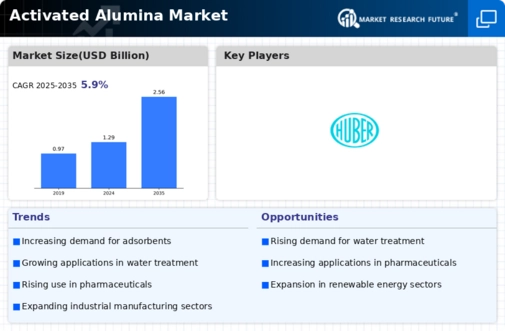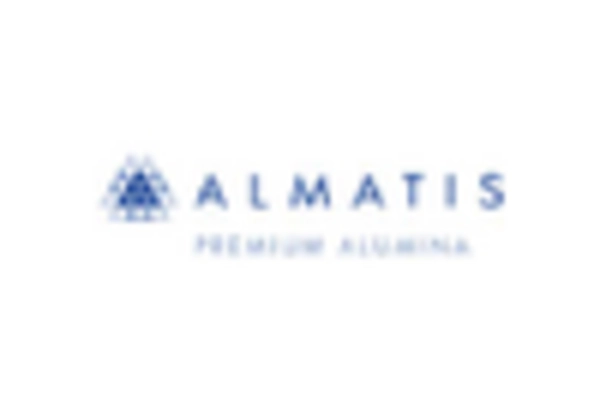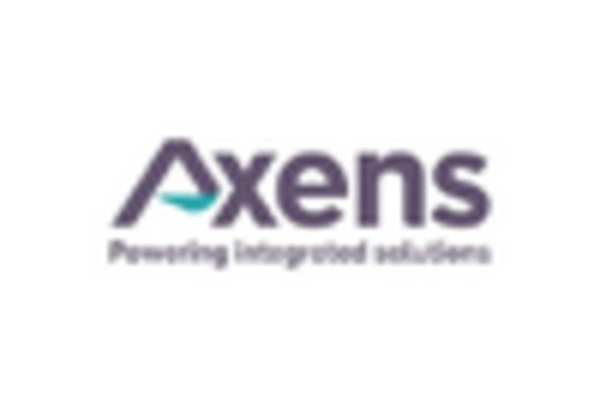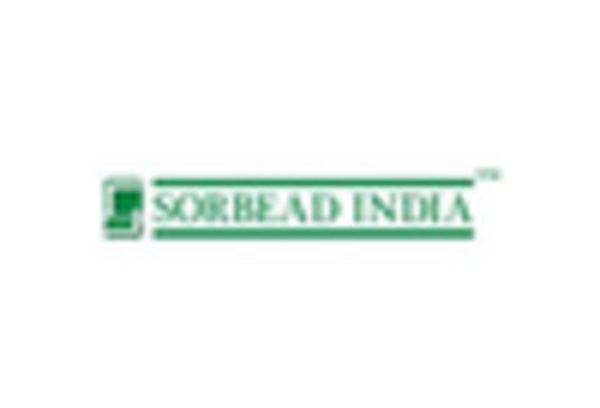-
Executive Summary
-
Market Introduction
-
Market Definition
-
Scope of the
- Research
- Assumptions & Limitations
-
Study
-
Objectives
-
Markets Structure
-
Key Takeaways
-
Market Research Methodology
-
Research Process
-
Primary Research
-
Secondary Research
-
Market Size Estimation
-
Forecast Model
-
Market Dynamics of the Global Activated
-
Alumina Market
-
Introduction
-
Drivers
-
Restraints
-
Opportunities
-
Challenges
-
Trends/Technology
-
Market Factor Analysis of the Global Activated Alumina
-
Market
-
Supply Chain Analysis
- Raw Material Suppliers
- Distributors/Retailers/Wholesalers/E-Commerce
- End User
- Bargaining
- Bargaining Power
- Threat of Substitutes
- Intensity of Competitive Rivalry
-
Manufacturers/Producers
-
Porter’s Five Forces Analysis
-
Threat of New Entrants
-
Power of Buyers
-
of Suppliers
-
Pricing Analysis
-
Global Activated Alumina Market,
-
by Application
-
Introduction
-
Catalyst
- Market Estimates
- Market Estimates & Forecast, by
-
& Forecast, 2020-2027
-
Region, 2020-2027
-
Desiccant
- Market Estimates & Forecast, 2020-2027
- Market Estimates & Forecast, by Region, 2020-2027
- Market Estimates &
-
Absorbent
-
Market Estimates & Forecast, 2020-2027
-
Forecast, by Region, 2020-2027
-
Others
- Market Estimates & Forecast,
- Market Estimates & Forecast, by Region, 2020-2027
-
Global Activated Alumina Market, by End-Use Industry
-
Introduction
-
Water treatment
- Market Estimates &
-
Market Estimates & Forecast, 2020-2027
-
Forecast, by Region, 2020-2027
-
Pharmaceutical
- Market Estimates
-
Market Estimates & Forecast, 2020-2027
-
& Forecast, by Region, 2020-2027
-
Textile
- Market Estimates
-
Market Estimates & Forecast, 2020-2027
-
& Forecast, by Region, 2020-2027
-
Oil & Gas
- Market Estimates & Forecast, 2020-2027
- Market
-
Estimates & Forecast, by Region, 2020-2027
-
Chemical
- Market Estimates & Forecast, 2020-2027
- Market
-
Estimates & Forecast, by Region, 2020-2027
-
Others
- Market Estimates & Forecast, 2020-2027
- Market
-
Estimates & Forecast, by Region, 2020-2027
-
Global
-
Activated Alumina Market, by Region
-
Introduction
- Market Estimates & Forecast,
- Market Estimates & Forecast, by Application,
- Market Estimates & Forecast, by End-Use Industry,
- US
- Market Estimates & Forecast, 2020-2027
- Market Estimates & Forecast, by Application, 2020-2027
- Market Estimates & Forecast, by End-Use Industry, 2020-2027
- Germany
- France
- Italy
- Russia
- Poland
-
North America
-
by Application, 2020-2027
-
Market Estimates & Forecast, End-Use Industry, 2020-2027
-
Canada
-
Market Estimates & Forecast, 2020-2027
-
Estimates & Forecast, by End-Use Industry, 2020-2027
-
Europe
-
by Application, 2020-2027
-
by Application, 2020-2027
-
Estimates & Forecast, by End-Use Industry, 2020-2027
-
Spain
-
Market Estimates & Forecast, 2020-2027
-
& Forecast, by End-Use Industry, 2020-2027
-
UK
-
& Forecast, 2020-2027
-
Forecast, by End-Use Industry, 2020-2027
-
& Forecast, 2020-2027
-
Forecast, by End-Use Industry, 2020-2027
-
Forecast, 2020-2027
-
Market Estimates & Forecast, by Application, 2020-2027
-
by End-Use Industry, 2020-2027
-
& Forecast, 2020-2027
-
& Forecast, by End-Use Industry, 2020-2027
-
Market Estimates & Forecast,
-
Rest of Europe
-
Market Estimates
-
Market Estimates & Forecast, by Application, 2020-2027
-
Market Estimates
-
Asia-Pacific
- Market Estimates & Forecast, 2020-2027
-
Market Estimates & Forecast, by Application, 2020-2027
-
Market Estimates & Forecast, by End-Use Industry, 2020-2027
-
Market Estimates & Forecast, 2020-2027
-
by Application, 2020-2027
-
& Forecast, by Application, 2020-2027
-
& Forecast, by Application, 2020-2027
-
& Forecast, 2020-2027
-
& Forecast, by End-Use Industry, 2020-2027
-
Rest of Asia-Pacific
-
Market Estimates & Forecast, 2020-2027
-
China
-
Market Estimates & Forecast,
-
Market Estimates & Forecast, by End-Use Industry, 2020-2027
-
India
-
Market Estimates & Forecast, 2020-2027
-
Market Estimates
-
Market Estimates & Forecast, by End-Use Industry,
-
Japan
-
Market Estimates & Forecast, 2020-2027
-
Market Estimates
-
Market Estimates & Forecast, by End-Use Industry,
-
Australia & New Zealand
-
Market Estimates
-
Market Estimates & Forecast, by Application, 2020-2027
-
Market Estimates
-
Market Estimates & Forecast, by Application,
-
Market Estimates & Forecast, by End-Use Industry, 2020-2027
-
Middle East & Africa
- Market Estimates & Forecast, 2020-2027
-
Market Estimates & Forecast, by Application, 2020-2027
-
Market Estimates & Forecast, by End-Use Industry, 2020-2027
-
Market Estimates & Forecast, 2020-2027
-
& Forecast, by End-Use Industry, 2020-2027
-
& Forecast, 2020-2027
-
Forecast, by End-Use Industry, 2020-2027
-
Africa
-
Market Estimates & Forecast, 2020-2027
-
& Forecast, by End-Use Industry, 2020-2027
-
Turkey
-
Estimates & Forecast, 2020-2027
-
& Forecast, by End-Use Industry, 2020-2027
-
of Middle East & Africa
-
by Application, 2020-2027
-
Forecast, 2020-2027
-
by Application, 2020-2027
-
by End-Use Industry, 2020-2027
-
Forecast, 2020-2027
-
GCC
-
Market Estimates & Forecast, by Application, 2020-2027
-
Market Estimates
-
Israel
-
Market Estimates
-
Market Estimates & Forecast, by Application, 2020-2027
-
Market Estimates &
-
North
-
Market Estimates & Forecast, by Application, 2020-2027
-
Market Estimates
-
Market
-
Market Estimates & Forecast, by Application, 2020-2027
-
Market Estimates
-
Rest
-
Market Estimates & Forecast, 2020-2027
-
Market Estimates & Forecast,
-
Market Estimates & Forecast, by End-Use Industry, 2020-2027
-
Latin America
- Market Estimates &
- Market Estimates & Forecast,
- Market Estimates & Forecast,
- Brazil
-
Market Estimates & Forecast, by Application, 2020-2027
-
by End-Use Industry, 2020-2027
-
& Forecast, 2020-2027
-
Forecast, by End-Use Industry, 2020-2027
-
& Forecast, 2020-2027
-
Forecast, by End-Use Industry, 2020-2027
-
of Latin America
-
Market Estimates & Forecast, 2020-2027
-
Estimates & Forecast, by End-Use Industry, 2020-2027
-
Market Estimates & Forecast,
-
Argentina
-
Market Estimates
-
Market Estimates & Forecast, by Application, 2020-2027
-
Market Estimates &
-
Mexico
-
Market Estimates
-
Market Estimates & Forecast, by Application, 2020-2027
-
Market Estimates &
-
Rest
-
Market Estimates & Forecast, by Application,
-
Market
-
Company
-
Landscape
-
Introduction
-
Market Strategy
-
Key Development
-
Analysis (Expansion/Merger & Acquisitions/Joint Venture/New Product Development/Agreement/Investment)
-
Company Profiles
-
BASF SE
-
Company Overview
-
Key Developments
-
Company Overview
-
Key Developments
-
Financial Updates
-
Product/Business Segment Overview
-
Strategies
-
SWOT Analysis
-
Company Overview
-
Key Developments
-
Financial Updates
-
Product/Business Segment Overview
-
Strategies
-
SWOT Analysis
-
Company Overview
-
Key Developments
-
Company Overview
-
Key Developments
-
Company Overview
-
Key Developments
-
Ltd
-
Company Overview
-
Key Developments
-
Financial Updates
-
Product/Business Segment Overview
-
Strategies
-
SWOT Analysis
-
AGC Chemicals Pvt. Ltd
-
Overview
-
Key Strategies
-
Financial Updates
-
Product/Business Segment Overview
-
Key Strategies
-
SWOT Analysis
-
Honeywell International Inc.
- Financial Updates
- Product/Business Segment Overview
- Key Strategies
- SWOT Analysis
-
Sumitomo Chemical Co
- Company Overview
- Key
- Key Developments
-
Porocel Industries LLC
- Financial Updates
- Product/Business Segment Overview
- Key Strategies
- SWOT Analysis
-
Dynamic Adsorbents Inc.
- Company Overview
- Key
- Key Developments
-
Axens SA
- Financial Updates
- Product/Business Segment Overview
- Key Strategies
- SWOT Analysis
-
Shandong Zhongxin New Material Technology Co., Ltd
- Financial Updates
- Product/Business Segment Overview
- Key Strategies
- SWOT Analysis
-
Huber Engineered Materials
- Financial Updates
- Product/Business Segment Overview
- Key Strategies
- SWOT Analysis
-
Jiangxi Sanxin Hi-Tech Ceramics Co.,
- Financial Updates
- Product/Business Segment Overview
- Key Strategies
- SWOT Analysis
-
Sialca Industries
- Company Overview
- Key
- Key Developments
- Company
- Financial Updates
- Product/Business Segment Overview
- Key Developments
- SWOT Analysis
-
Conclusion
-
LIST OF TABLES
-
Table 1
-
Global Activated Alumina Market: by Region, 2020-2027
-
Table 2
-
North America: Activated Alumina Market, by Country, 2020-2027
-
Table
-
Europe: Activated Alumina Market, by Country, 2020-2027
-
Table
-
Asia-Pacific: Activated Alumina Market. by Country, 2020-2027
-
Middle East & Africa: Activated Alumina Market,
-
by Country, 2020-2027
-
Latin America: Activated Alumina
-
Market, by Country, 2020-2027
-
Global Activated Alumina
-
Application Market, by Regions, 2020-2027
-
North America:
-
Activated Alumina Application Market, by Country, 2020-2027
-
Table 9
-
Europe: Activated Alumina Application Market, by Country, 2020-2027
-
Table10
-
Asia-Pacific: Activated Alumina Application Market, by Country, 2020-2027
-
Table11 Middle East & Africa: Activated Alumina Application
-
Market, by Country, 2020-2027
-
Table12 Latin America: Activated
-
Alumina Application Market, by Country, 2020-2027
-
Table13 Global
-
Activated Alumina End-Use Industry Market, by Regions, 2020-2027
-
Table14
-
North America: Activated Alumina End-Use Industry Market, by Country, 2020-2027
-
Table15 Europe: Activated Alumina End-Use Industry Market, by
-
Country, 2020-2027
-
Table16 Asia-Pacific: Activated Alumina
-
End-Use Industry Market, by Country, 2020-2027
-
Table17 Middle
-
East & Africa: Activated Alumina End-Use Industry Market, by Country, 2020-2027
-
Table18 Latin America: Activated Alumina by End-Use Industry
-
Market, by Country, 2016-2023
-
Table19 Global Application
-
Market, by Region, 2020-2027
-
Table20 Global End-Use Industry
-
Market, by Region, 2020-2027
-
Table21 North America: Activated
-
Alumina Market, by Country, 2020-2027
-
Table22 North
-
America: Activated Alumina Market, by Application, 2020-2027
-
Table23
-
North America: Activated Alumina Market, by End-Use Industry, 2020-2027
-
Table24 Europe: Activated Alumina Market, by Country, 2020-2027
-
Table25 Europe: Activated Alumina Market, by Application, 2020-2027
-
Table26 Europe: Activated Alumina Market, by End-Use Industry,
-
Table27 Asia-Pacific: Activated Alumina
-
Market, by Country, 2020-2027
-
Table28 Asia-Pacific:
-
Activated Alumina Market, by Application, 2020-2027
-
Table29 Asia-Pacific:
-
Activated Alumina Market, by End-Use Industry, 2020-2027
-
Table30
-
Middle East & Africa: Activated Alumina Market, by Country, 2020-2027
-
Table31 Middle East & Africa: Activated Alumina Market,
-
by Application, 2020-2027
-
Table32 Middle East &
-
Africa: Activated Alumina Market, by End-Use Industry, 2020-2027
-
Table33
-
Latin America: Activated Alumina Market, by Country, 2020-2027
-
Table34
-
Latin America: Activated Alumina Market, by Application, 2020-2027
-
Table35
-
Latin America: Activated Alumina Market, by End-Use Industry, 2020-2027
-
LIST OF FIGURES
-
Global Activated Alumina
-
Market Segmentation
-
Forecast Research Methodology
-
Five Forces Analysis of the Global Activated Alumina Market
-
Value Chain of the Global Activated Alumina Market
-
FIGURE
-
Global Activated Alumina Market, 2020-2027, by Country, 2020
-
Share of Global Activated Alumina Market, by Application,
-
Global Activated Alumina Market Size, by Application,
-
Share of the Global Activated Alumina Market, by
-
Application, 2020-2027
-
Global Activated Alumina Market
-
Size, by End-Use Industry, 2020
-
FIGURE10 Share of the Global Activated
-
Alumina Market, by End-Use Industry, 2020-2027

















Leave a Comment